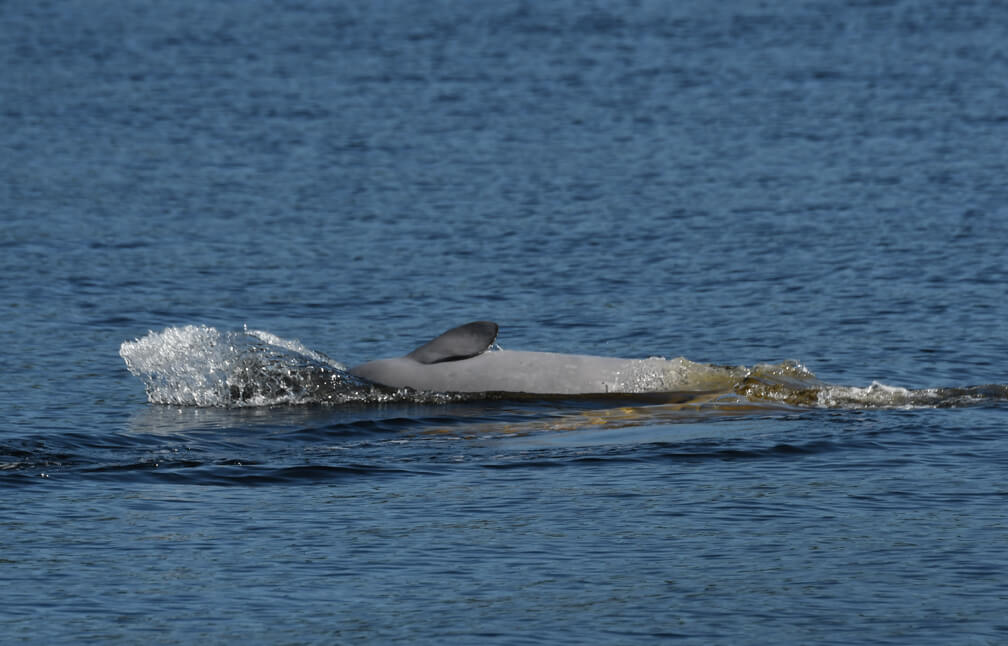September 6: While part of the team is returning from Alaska to lend a hand to researchers studying the beluga population of Cook Inlet, another is taking off on board our small inflatable research craft, the BpJAM. The weather forecast is calling for smooth waters on the south shore, while the north shore is covered with whitecaps. We therefore first head toward Île Verte.
Spotting a herd of white backs, we approach and study their behaviour and distribution for 15 minutes or so. Captain and drone pilot Timothée Perrero speaks with Mathieu Marzelière, who is responsible for photographing the belugas and conducting visual surveys. Which group will they shoot first? To avoid taking too many duplicate photos (and wasting precious time analyzing superfluous data), Mathieu makes a mental note of the markings and scars visible on the belugas. Once the left flank of each beluga in the group is photographed, we proceed with the right. Why so?, you might ask. Some belugas are only recognizable from one side, for example if the other flank is devoid of markings or scars and therefore not easily discernible from others. “Ah, this one has a really nice ridge,” he exclaims, his eye glued to the viewfinder. Marie-Hélène D’Arcy, beluga technician and “match-maker”, will surely succeed in recognizing the individual and adding information to its life story. Once the belugas have been photographed, Timothée prepares the drone. He flies the machine over the groups to study their behaviour.
Just opposite the village of Cacouna, the belugas’ backs glimmer in the sun. But the closer the Zodiac approaches, the more the team sees that there are more than just backs. Pectoral fins, tails, and melons (the bulging part of the forehead) are seen poking above the water. Not far away, two belugas are “logging” at the surface. Are they sleeping? One of the belugas seems to have a spasm, and both individuals slap their tails before taking a dive. We photograph the different groups, but they are so active that their dorsal ridges are difficult to capture with our cameras.
We launch the drone to see why they are so agitated. Some of their vocalizations even reach our ears despite the buzzing propellers of the drone. There’s action out here today! Mathieu indicates the position of a group with respect to that of the drone, while Timothée attempts to reach them with his flying camera. It’s almost like playing with a remote controlled car blindfolded…
Every 30 minutes, Mathieu records data in his voice recorder on the presence or absence of other boats nearby, changes in environmental factors, etc. The remote control lets out a beep, meaning the drone’s battery is running low. Timothée guides it back to the boat. Second flight. On the screen that retransmits the drone images, beluga silhouettes appear, but it’s impossible to analyze their behaviour this way. Once we’ve taken the time this winter to watch the videos, we’ll have a better idea what these hyperactive belugas were doing.
After two 20-minute flights (the duration of each of the drone’s batteries), it’s time to move to another herd.
A third encounter takes place, this time sans drone. In the golden light of the end of the day, the team returns to the docks. All that’s left to do is to ensure that the memory cards from the camera, the drone and the voice recorder are properly transferred and recorded, just to be sure that nothing is lost from this productive day.
Thanks to photo-ID techniques, the following individuals were identified in August…
Blanchon, Yolande Simard Perrault
DL0242, available for adoption
DL1688, available for adoption
DL2071, available for l’adoption
Gaston, Pratte Family
John A. Macdonald, The Fairmount Hotel Macdonald
JP, Jacob Issac
Miss Frontenac, Fairmount Hotel Château Frontenac
Nikamun, Project Red Alert, Tadoussac
Nomi, Tadoussac Elderhostel
Pure Laine, Cynthia Fish
Vita, Shaklee Canada Inc.
…and the narwhal!












